 
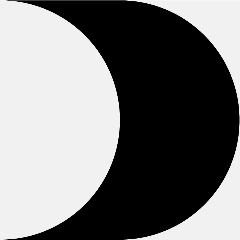 
 
the above jpeg images were based on visual analysis this photo of copacabana sidewalks. obviously a design of repetition so i looked for the seams in the irreducible portion of the pattern. i wanted to determine the possibility of making a single square tile that would created the Portuguese b&w endless wave pattern. as it turns out there must be two tiles. one with a black crescent moon shape (on a white field) with points leading left and one with a white moon (on black field) pointing right (rotated or flipped). the above pattern is two tiles across and three high.
note: the pattern could be accomplished with a single tile but the tiles would need to be laid staggered in a running bond pattern rather than on a square grid pattern.
i like how the moon shape ties into a wave pattern just as our moon has its effect on the tides. ive also noted several accounts nausea or instability when passing through large plazas paved in this pattern.
thanks to adman for the co-brainstorming.
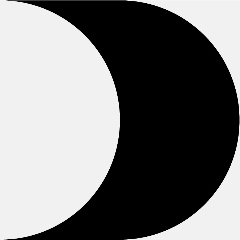 wave tile black moon wave tile black moon
 wave tile white moon wave tile white moon
Don't forget this one - http://blog.iso50.com/2008/05/12/lisbon-streets/
thanks justin. btw, this subject got kicked off for me on justins old blog. credit where credit is due.
You "formalist"--just kidding, looks good.
:)
Y'know, I would totally go for this. I think you're on to something here......
It worked! Call Steve the tile man and lets get into production.
thanks tom.
i will try and get this into production asap. 6" wall tile, 12" floor tiles.
is that for the vomitorium? i wouldnt want to be in that room drunk.
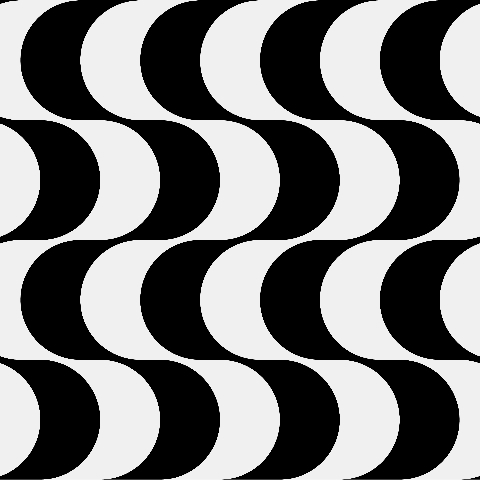 
It would fine on the floor or on one wall, but Dave is right - just imagine a whole room covered in this! OMG 8D
i didnt mean both in one room. just to make both sizes.
copacabana animated GIF
going to the gonz... site that is the ultimate source for the gif on lalblog.tumblr is not recommended (see comments on lalblog.tumblr)
thanks again tom.
id like to mention that tom re-blogged the top (slightly doctored-up) image with credit and link to this site over on nasty nets. and incorporated a couple of tiles into a viagra mix file logo composition over at tom moody dot us. also with credit and links.
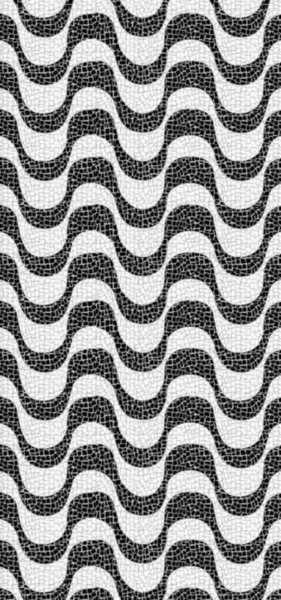 
gonzalogilescudero: a walk in Copacabana x2 (linked above in toms post)
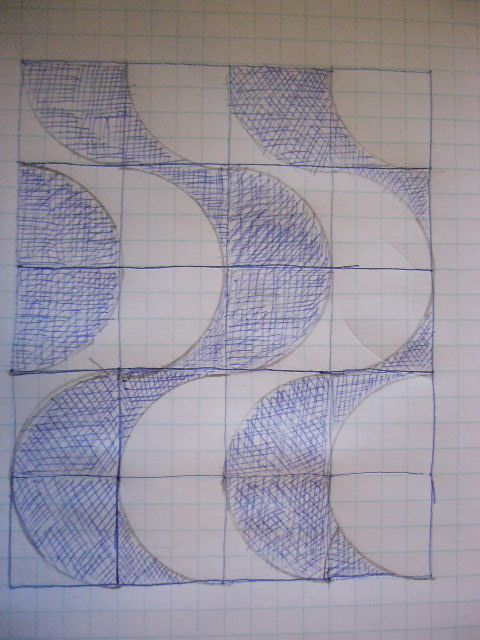
apparently i was too hasty in determining the tiles previously posted to be irreducible square patterns. by dividing the crescent moon tile into quarters i arrived on a simpler arced scallop (or fan) shape in the foreground with a tiny bit of triangular contrasting field remaining. one would still need two versions of these tiles (both black scallop on white and a white scallop on black) and plenty of rotation to complete the full black and white undulating wave pattern. in dont see how i can go any further in the reduction process with this project at this point.
the thumbnail sketch above is representative of my working process. freehand cross hatching with a ballpoint pen on graph paper with the assistance of a graphite loaded carpenters compass.
I'm probably wrong but it looks to me like it could be achieved with one tile if every other row were flopped.
one would think, but i cant find it.
One tile with either a black or white scallop. In either case the negative space creates the opposite scallop when tiles are ganged and flopped?
the grouping i posted on march 25th was made from the following tile:

this version was developed by adman a couple of weeks ago. it is shifted 25% (from the original centered version) to the right, which now puts the tips of the moon on the left side of the tile. i dont know how he came up with it. not mathematically, more intuitive. but this configuration will allow a single tile to be made and merely rotated into position to complete the full wave pattern. no negative version required. and it cannot be reduced further by quartering it into a scallop or other shape since its no longer symmetrical.
thanks steve. but i think the fatal flaw with the single scallop tile theory is that it is not a 50% black and 50% white tile. if you dont start out with a tile which is 50/50 b and w no way it will make a 50/50 b and w overall pattern. if i follow the self imposed rule that im looking for a single (50% b 50% w) square tile on a square grid pattern (not a running bond or common laid brick grid.) i think it appears adman has nailed it. although i still cant wrap my head around why the 25% (or one quarter) shift left or right makes it work. thats why i put it on the back burner and rushed forward with the scallop discovery. also my use of the terms foreground and background is arbitrary unless there is a rule about either black or white always being described in the fore as there well may be. i guess it just depends how the page is set up. black type on a white screen puts black in the foreground. context baby!
I'm taking partial credit for that tile 'cause I knew it could be achieved with one.
And what about the grout?
i still dont know how it works. the Portuguese seem to use a grey with the mosaics. glad to have your help and support steve.
here is a 4 x 4 version of the 25% shift tile with moon tips on left:
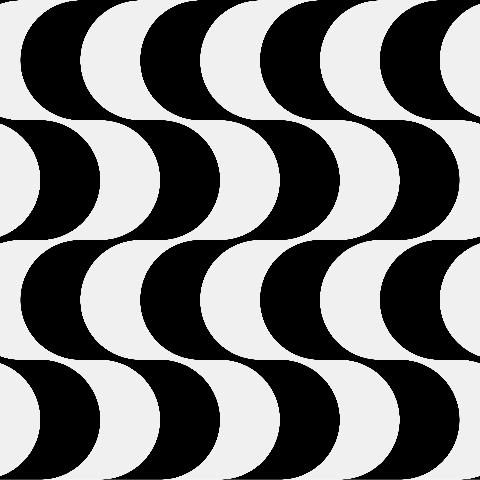


and of course this is an elsworth kelly. clearly yet subtlely different
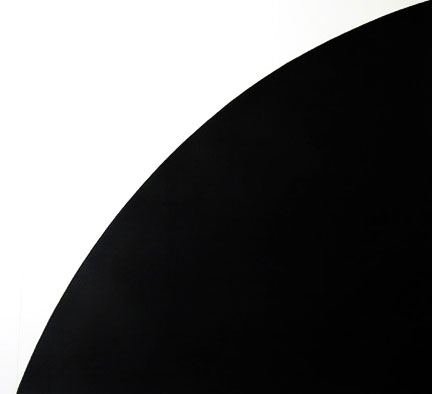
finally this thread is getting interesting..
I get so confused whenever I return to this thread.
for me its a reminder to actually make the damn tiles.
how do i end comments on this thread so i can close it?
You have to go to the thread itself (not from a /newcomments/ view) and then the option will be right below your original post.
Perhaps the most celebrated feature of Rio de Janeiro's legendary Copacabana Beach is its elegant mosaic pavements. During the construction and urbanization of Avenida Atlântica (1905-06), along Copacabana's curved, sandy beach, Mayor Francisco Pereira Passos imported both skilled craftsmen and stone from Portugal to pave the oceanfront promenade. The Portuguese artisans followed patterns typical of the distinctive paving of Portuguese walkways (calçada à portuguesa), entirely covered in alternating black-and-white waves composed of small stones cut and laid by hand. In his project for the renovation and extension of the pavements of Avenida Atlântica (Calçadão de Copacabana, 1969-72), Burle Marx retained the original pattern on the beachfront pavement - only accentuating the curves - preserving the memory of the colonial metropolis.(5) For the new pavements on the opposite side of the seafront and on the islands at the centre of the avenue, however, he used the same black and white stones combined with a red one to compose a magnificent four-kilometre-long abstract mosaic that pays tribute to the colonial artisan tradition - the old motif at times reappears in the form of fragmentary quotations - and imaginatively re-invents. Burle Marx's juxtaposition of the old and new mosaic pavements along Avenida Atlântica constitutes one of the most eloquent expressions of his lifelong ambition to elevate landscape design to the level of the fine arts.from here
|
- bill 3-25-2009 1:42 pm
the above jpeg images were based on visual analysis this photo of copacabana sidewalks. obviously a design of repetition so i looked for the seams in the irreducible portion of the pattern. i wanted to determine the possibility of making a single square tile that would created the Portuguese b&w endless wave pattern. as it turns out there must be two tiles. one with a black crescent moon shape (on a white field) with points leading left and one with a white moon (on black field) pointing right (rotated or flipped). the above pattern is two tiles across and three high.
note: the pattern could be accomplished with a single tile but the tiles would need to be laid staggered in a running bond pattern rather than on a square grid pattern.
i like how the moon shape ties into a wave pattern just as our moon has its effect on the tides. ive also noted several accounts nausea or instability when passing through large plazas paved in this pattern.
thanks to adman for the co-brainstorming.
- bill 3-25-2009 2:50 pm [add a comment]
- bill 3-25-2009 3:17 pm [add a comment]
Don't forget this one - http://blog.iso50.com/2008/05/12/lisbon-streets/
- Justin (guest) 3-25-2009 4:03 pm [add a comment]
thanks justin. btw, this subject got kicked off for me on justins old blog. credit where credit is due.
- bill 3-25-2009 4:08 pm [add a comment]
You "formalist"--just kidding, looks good.
- tom moody 3-25-2009 4:15 pm [add a comment]
:)
Y'know, I would totally go for this. I think you're on to something here......
- Justin (guest) 3-25-2009 6:58 pm [add a comment]
It worked! Call Steve the tile man and lets get into production.
- adman 3-25-2009 8:43 pm [add a comment]
thanks tom.
i will try and get this into production asap. 6" wall tile, 12" floor tiles.
- bill 3-25-2009 9:45 pm [add a comment]
is that for the vomitorium? i wouldnt want to be in that room drunk.
- dave 3-25-2009 10:04 pm [add a comment]
- bill 3-26-2009 4:10 am [add a comment]
It would fine on the floor or on one wall, but Dave is right - just imagine a whole room covered in this! OMG 8D
- Justin (guest) 3-26-2009 7:39 pm [add a comment]
i didnt mean both in one room. just to make both sizes.
- bill 3-26-2009 8:11 pm [add a comment]
copacabana animated GIF
going to the gonz... site that is the ultimate source for the gif on lalblog.tumblr is not recommended (see comments on lalblog.tumblr)
- tom moody 3-31-2009 6:44 pm [add a comment]
thanks again tom.


id like to mention that tom re-blogged the top (slightly doctored-up) image with credit and link to this site over on nasty nets. and incorporated a couple of tiles into a viagra mix file logo composition over at tom moody dot us. also with credit and links.
gonzalogilescudero: a walk in Copacabana x2 (linked above in toms post)
- bill 3-31-2009 8:54 pm [add a comment]
apparently i was too hasty in determining the tiles previously posted to be irreducible square patterns. by dividing the crescent moon tile into quarters i arrived on a simpler arced scallop (or fan) shape in the foreground with a tiny bit of triangular contrasting field remaining. one would still need two versions of these tiles (both black scallop on white and a white scallop on black) and plenty of rotation to complete the full black and white undulating wave pattern. in dont see how i can go any further in the reduction process with this project at this point.
the thumbnail sketch above is representative of my working process. freehand cross hatching with a ballpoint pen on graph paper with the assistance of a graphite loaded carpenters compass.
- bill 4-04-2009 5:42 pm [add a comment]
I'm probably wrong but it looks to me like it could be achieved with one tile if every other row were flopped.
- steve 4-05-2009 10:17 am [add a comment]
one would think, but i cant find it.
- bill 4-05-2009 2:58 pm [add a comment]
One tile with either a black or white scallop. In either case the negative space creates the opposite scallop when tiles are ganged and flopped?
- steve 4-05-2009 4:59 pm [add a comment]
Sorry, rotated, not flopped.
- steve 4-05-2009 5:01 pm [add a comment]
the grouping i posted on march 25th was made from the following tile:

this version was developed by adman a couple of weeks ago. it is shifted 25% (from the original centered version) to the right, which now puts the tips of the moon on the left side of the tile. i dont know how he came up with it. not mathematically, more intuitive. but this configuration will allow a single tile to be made and merely rotated into position to complete the full wave pattern. no negative version required. and it cannot be reduced further by quartering it into a scallop or other shape since its no longer symmetrical.
thanks steve. but i think the fatal flaw with the single scallop tile theory is that it is not a 50% black and 50% white tile. if you dont start out with a tile which is 50/50 b and w no way it will make a 50/50 b and w overall pattern. if i follow the self imposed rule that im looking for a single (50% b 50% w) square tile on a square grid pattern (not a running bond or common laid brick grid.) i think it appears adman has nailed it. although i still cant wrap my head around why the 25% (or one quarter) shift left or right makes it work. thats why i put it on the back burner and rushed forward with the scallop discovery. also my use of the terms foreground and background is arbitrary unless there is a rule about either black or white always being described in the fore as there well may be. i guess it just depends how the page is set up. black type on a white screen puts black in the foreground. context baby!
- bill 4-06-2009 2:45 pm [add a comment]
I'm taking partial credit for that tile 'cause I knew it could be achieved with one.
- steve 4-08-2009 9:18 am [add a comment]
And what about the grout?
- steve 4-08-2009 9:20 am [add a comment]
i still dont know how it works. the Portuguese seem to use a grey with the mosaics. glad to have your help and support steve.
- bill 4-08-2009 12:03 pm [add a comment]
here is a 4 x 4 version of the 25% shift tile with moon tips on left:

- bill 4-06-2009 3:03 pm [add a comment]
- bill 4-06-2009 11:35 pm [add a comment]
- bill 4-06-2009 11:36 pm [add a comment]
and of course this is an elsworth kelly. clearly yet subtlely different

- bill 4-07-2009 1:16 pm [add a comment]
finally this thread is getting interesting..
- dave 6-19-2009 7:29 am [add a comment]
I get so confused whenever I return to this thread.
- L.M. 3-06-2010 2:56 pm [add a comment]
for me its a reminder to actually make the damn tiles.
- bill 3-06-2010 3:39 pm [add a comment]
how do i end comments on this thread so i can close it?
- bill 3-15-2010 2:08 pm [add a comment]
You have to go to the thread itself (not from a /newcomments/ view) and then the option will be right below your original post.
- jim 3-15-2010 2:44 pm [add a comment]
Perhaps the most celebrated feature of Rio de Janeiro's legendary Copacabana Beach is its elegant mosaic pavements. During the construction and urbanization of Avenida Atlântica (1905-06), along Copacabana's curved, sandy beach, Mayor Francisco Pereira Passos imported both skilled craftsmen and stone from Portugal to pave the oceanfront promenade. The Portuguese artisans followed patterns typical of the distinctive paving of Portuguese walkways (calçada à portuguesa), entirely covered in alternating black-and-white waves composed of small stones cut and laid by hand. In his project for the renovation and extension of the pavements of Avenida Atlântica (Calçadão de Copacabana, 1969-72), Burle Marx retained the original pattern on the beachfront pavement - only accentuating the curves - preserving the memory of the colonial metropolis.(5) For the new pavements on the opposite side of the seafront and on the islands at the centre of the avenue, however, he used the same black and white stones combined with a red one to compose a magnificent four-kilometre-long abstract mosaic that pays tribute to the colonial artisan tradition - the old motif at times reappears in the form of fragmentary quotations - and imaginatively re-invents. Burle Marx's juxtaposition of the old and new mosaic pavements along Avenida Atlântica constitutes one of the most eloquent expressions of his lifelong ambition to elevate landscape design to the level of the fine arts.from here
- bill 11-09-2014 12:36 pm [add a comment]